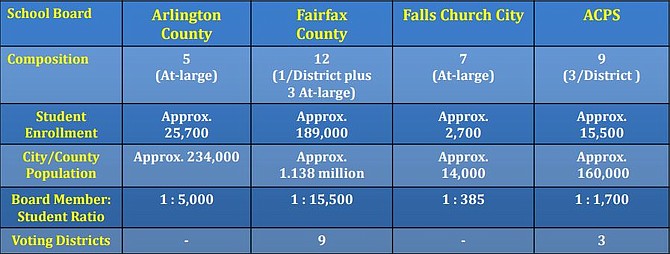The end of the school year marks a time for change for a lot of families. Children are headed off to college or going to new schools, and many parents take inventory of things they may no longer need — like old textbooks, notebooks, and three to four School Board members.
The Alexandria School Board has started looking at thinning its numbers, shifting from a nine-member board to a more manageable five or six. During a May 31 work session, the School Board reviewed the numbers change and other potential election changes, such as having staggered elections instead of concurrent terms, and including at-large members who don’t represent specific districts.
Any change to the School Board elections would require a approval from City Council. School staff said a voter referendum wouldn’t be required but would likely be involved. The last major change to School Board elections were in 1994, when it shifted form an appointed board to an elected one.
School Board member Christopher Lewis said he was interested in gathering more community feedback on a smaller School Board. Others expressed strong support for a reduced board size.
“I’m very much interested in this, particularly size of the School Board,” said School Board member Veronica Nolan. “Data shows this School Board is too large for this size of district. Only 10 school boards have nine members. There’s significantly larger school boards that have five, like neighboring Arlington. Size is something to be looked at. It prevents us from being as efficient as we could be.”
One of the topics of discussion was how many members would comprise the new board. Traditional logic would say an odd number, like five, to avoid tie votes. There was even some laughter at the description of an elected non-board member who existed solely as a tiebreaker. However, members of the board still expressed curiosity, if not interest, in an even number board.
“[Years ago] I would have said an even number board was ridiculous,” said School Board Chair Ramee Gentry. “There’s no way I could even remotely think that would work. But I find myself thinking of a version of six, with two in each district. [Votes would be] going for four. [They would] need at least a four-two vote. That would send a strong message: nothing would pass without a two-thirds vote. If something only makes three-three, that means it needs further consensus.”
Gentry also said the board would be stronger and more consistent with staggered elections.
“For any governing body to have possibility every single election of significant, more than half turnover, can have a sizable impact on effectiveness and continuity,” said Gentry. “From a voting perspective, considering the ability to focus down and consider on smaller number of candidates would allow me as a voter to focus more intently on a smaller number of people. When I think of some of the candidate forums some of us attended when we were candidates: I’m not sure how substantive that is and how informed that is. I think I could make a lot of really good cases for staggered elections.”
School Board Member Ronnie Campbell said this had happened in her first election, where eight of the nine School Board members were completely new.
“I look at all the people coming on now, like for School Board or City Council, a lot of people coming in new,” said Campbell. “As far as knowledge goes; do you really want an almost entirely new board? That won’t happen with staggered terms.”
While many on the board agreed with the central premise, that a smaller board could work more effectively, there were questions about whether it was a policy worth pursuing without a consensus of clear vision for what the board wanted.
“Should we even pursue this?” said School Board Member Karen Graf. “I think this is very complex and deals with more politics … It strikes me as a lot more involved and complex when I can’t get a read on what we think as a body. If we were all to wave our wand and have a wish we’d want staggered elections, but we would have to go through this governance body. I’m just wondering if we even have enough of a fully baked idea or theory about why now and whether or not the timing works for sending a resolution. As much as I love exploring this, I’m not sure this is a hill to climb right now unless one of you can make a really compelling case for it. If someone were to pull me aside on the street, don’t think I have enough confidence in a design or a plan to take to City Council.”
But the consensus on the board was that there was enough interest in the item to move it forward, though with a narrowed down version that focused on staggered elections and reducing the number of board members.

